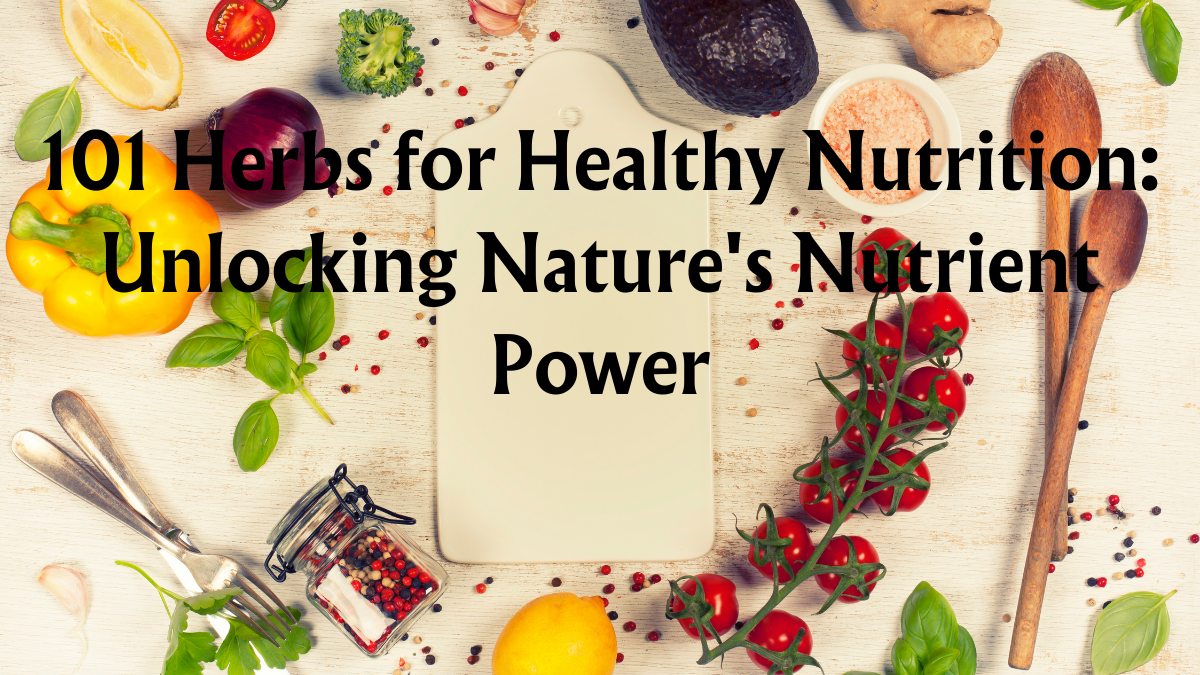101 Herbs for Healthy Nutrition: Unlocking Nature’s Nutrient Power
Herbs have been treasured for centuries not only for their aromatic flavors but also for their myriad health benefits. Packed with essential nutrients, vitamins, and antioxidants, incorporating a variety of herbs into your diet can contribute to overall well-being. Here are 101 herbs renowned for their nutritional value:
1-20: Culinary Classics
- 1. Basil
- 2. Thyme
- 3. Rosemary
- 4. Parsley
- 5. Cilantro
- 6. Mint
- 7. Oregano
- 8. Dill
- 9. Sage
- 10. Chives
- 11. Bay Leaves
- 12. Tarragon
- 13. Coriander
- 14. Marjoram
- 15. Lavender
- 16. Fennel
- 17. Lemongrass
- 18. Cumin
- 19. Bay Laurel
- 20. Chervil
21-40: Leafy Greens
- 21. Spinach
- 22. Kale
- 23. Arugula
- 24. Watercress
- 25. Swiss Chard
- 26. Dandelion
- 27. Collard Greens
- 28. Mustard Greens
- 29. Sorrel
- 30. Nettles
- 31. Purslane
- 32. Beet Greens
- 33. Lambsquarters
- 34. Moringa
- 35. Vietnamese Coriander
- 36. Malabar Spinach
- 37. Red Clover
- 38. Plantain
- 39. Shiso (Perilla)
- 40. Gotu Kola
41-60: Medicinal Powerhouses
- 41. Turmeric
- 42. Ginger
- 43. Garlic
- 44. Cinnamon
- 45. Ashwagandha
- 46. Astragalus
- 47. Echinacea
- 48. Milk Thistle
- 49. Peppermint
- 50. Chamomile
- 51. Lemon Balm
- 52. Holy Basil (Tulsi)
- 53. Catnip
- 54. Valerian
- 55. Licorice Root
- 56. Ginseng
- 57. Calendula
- 58. Elderberry
- 59. Yarrow
- 60. Goldenseal
61-80: Exotic Treasures
- 61. Cardamom
- 62. Saffron
- 63. Sumac
- 64. Za’atar
- 65. Fenugreek
- 66. Nigella Seeds
- 67. Star Anise
- 68. Lemongrass
- 69. Kaffir Lime Leaves
- 70. Pandan
- 71. Galangal
- 72. Epazote
- 73. Tamarind
- 74. Mace
- 75. Grains of Paradise
- 76. Ajwain
- 77. Lovage
- 78. Tarragon
- 79. Savory
- 80. Myrrh
81-101: Nutrient-Rich Wonders
- 81. Alfalfa
- 82. Nasturtium
- 83. Amaranth
- 84. Chia Seeds
- 85. Flaxseeds
- 86. Hemp Seeds
- 87. Pumpkin Seeds
- 88. Sunflower Seeds
- 89. Sesame Seeds
- 90. Poppy Seeds
- 91. Black Seed (Nigella Sativa)
- 92. Dulse
- 93. Spirulina
- 94. Chlorella
- 95. Aloe Vera
- 96. Comfrey
- 97. Red Clover
- 98. Chickweed
- 99. Mullein
- 100. Plantain
- 101. Cleavers
Incorporate these herbs into your daily meals, teas, or infusions to enjoy not only delightful flavors but also the incredible nutritional benefits they offer.

1-20: Culinary Classics
1. Basil
Basil, with its aromatic leaves, is a staple in Mediterranean cuisine. Rich in antioxidants and essential oils, it adds a burst of flavor to dishes while offering anti-inflammatory properties.
2. Thyme
Thyme is a versatile herb known for its earthy, slightly sweet flavor. Packed with vitamins C and A, thyme also possesses antimicrobial properties, making it a beneficial addition to both culinary and medicinal uses.
3. Rosemary
Rosemary, with its pine-like aroma, enhances the taste of various dishes. This herb contains rosmarinic acid, which has anti-inflammatory and antioxidant effects, contributing to overall health.
4. Parsley
Beyond being a garnish, parsley is a nutrient powerhouse. High in vitamins K, C, and A, it supports bone health and immune function, making it an excellent addition to salads and sauces.
5. Cilantro
Cilantro’s bright, citrusy flavor complements many dishes. Rich in vitamins and minerals, cilantro also aids in detoxification and may have antimicrobial properties.
6. Mint
Mint, known for its refreshing taste, has digestive benefits. It may soothe indigestion and alleviate symptoms of irritable bowel syndrome (IBS), making it a delightful addition to teas and desserts.
7. Oregano
Oregano is not just a pizza topping; it’s a potent herb with antimicrobial properties. Rich in antioxidants, oregano adds a robust flavor to dishes while supporting overall health.
8. Dill
Dill’s feathery leaves impart a unique flavor to salads, dips, and seafood. It contains compounds with anti-inflammatory and antioxidant properties, promoting well-being.
9. Sage
Sage, with its savory and slightly peppery taste, has potential cognitive benefits. It may enhance memory and concentration, making it a flavorful and brain-boosting herb.
10. Chives
Chives, part of the onion family, contribute a mild onion flavor to various dishes. They contain allicin, a compound with potential antibacterial and anti-inflammatory properties.
11. Bay Leaves
Bay leaves add depth to soups and stews. They contain essential oils with antimicrobial properties and may aid digestion, making them a subtle yet impactful herb.
12. Tarragon
Tarragon’s distinct anise-like flavor pairs well with poultry and fish. It contains compounds with potential antioxidant and anti-inflammatory effects, contributing to health.
13. Coriander
Coriander, both an herb and spice, offers a citrusy, warm flavor. Rich in antioxidants, it may have digestive benefits and add complexity to various cuisines.
14. Marjoram
Marjoram, a milder cousin of oregano, lends a sweet and floral taste. It contains vitamins and minerals, adding not only flavor but also nutritional value to dishes.
15. Lavender
Lavender’s fragrant blooms are not just for potpourri; they can infuse culinary creations. Known for their calming properties, lavender flowers may be used sparingly in both sweet and savory dishes.
16. Fennel
Fennel, with its subtle licorice flavor, is both a herb and vegetable. It aids digestion, provides dietary fiber, and adds a unique taste to salads and side dishes.
17. Lemongrass
Lemongrass, often used in Asian cuisine, has a citrusy and herbal profile. It contains essential oils with potential anti-inflammatory and antimicrobial properties.
18. Cumin
Cumin’s warm and earthy flavor is a staple in many spice blends. Beyond its culinary uses, cumin may have antioxidant properties and contribute to digestive health.
19. Bay Laurel
Bay laurel leaves, commonly used in soups and stews, have a subtle herbal flavor. They contain essential oils with potential anti-inflammatory and antioxidant effects.
20. Chervil
Chervil, with its delicate anise-like taste, is often used in French cuisine. It adds a fresh and mild flavor to dishes, along with potential antioxidant benefits.
Incorporate these herbs into your cooking to not only elevate the taste of your meals but also enjoy their unique health-promoting properties.

21-40: Leafy Greens for Vibrant Health
Leafy greens are nutritional powerhouses, offering an array of vitamins, minerals, and antioxidants. Including these vibrant greens in your diet can contribute to overall well-being. Let’s explore the diverse world of leafy greens from 21 to 40:
21. Spinach
Spinach, a versatile green, is rich in iron, and vitamins A and C. Its mild flavor makes it a great addition to salads, smoothies, and cooked dishes.
22. Kale
Kale, known for its robust texture, is packed with nutrients like fiber, and vitamins K, A, and C. Enjoy it in salads, soups, or baked into crunchy kale chips.
23. Arugula
Arugula adds a peppery kick to salads and sandwiches. Rich in nitrates, it may contribute to lower blood pressure and improved exercise performance.
24. Watercress
Watercress, with a slightly spicy taste, is dense in vitamins K and C. Add it to salads or use it as a garnish for a nutrient boost.
25. Swiss Chard
Swiss chard, with colorful stems, provides vitamins A, K, and C. Sauté or add it to soups for a delightful and nutritious dish.
26. Dandelion
Dandelion greens, often overlooked, are rich in vitamins A, C, and K. Use them in salads or sauté for a unique twist.
27. Collard Greens
Collard greens, a Southern staple, are high in fiber, and vitamins A and C. Enjoy them braised, sautéed, or added to soups.
28. Mustard Greens
Mustard greens offer a peppery flavor and are rich in vitamins K, A, and C. Incorporate them into salads or sauté with garlic for a tasty side.
29. Sorrel
Sorrel, with a tangy taste, contains vitamins A and C. Use it sparingly in salads, soups, or sauces for a burst of flavor.
30. Nettles
Nettles, known for their potential anti-inflammatory properties, can be steamed or brewed into a nourishing tea.
31. Purslane
Purslane, rich in omega-3 fatty acids, is a succulent green perfect for salads, sandwiches, or stir-fries.
32. Beet Greens
Beet greens, often discarded, are rich in iron and can be sautéed or added to salads for a nutritious boost.
33. Lambsquarters
Lambsquarters, a wild edible, are high in vitamins A and C. Cook them like spinach or add to omelets and soups.
34. Moringa
Moringa leaves, a superfood, are loaded with nutrients and can be added to smoothies, soups, or salads.
35. Vietnamese Coriander
Vietnamese coriander adds a spicy kick to dishes and is used in Vietnamese cuisine for its unique flavor.
36. Malabar Spinach
Malabar spinach, with thick leaves, is a heat-tolerant green perfect for salads, stir-fries, or soups.
37. Red Clover
Red clover greens, with a mild flavor, can be used in salads or cooked as a nutritious side dish.
38. Plantain
Plantain leaves, not to be confused with the banana-like fruit, are edible and can be used in salads or as a cooked green.
39. Shiso (Perilla)
Shiso, also known as perilla, has a unique flavor and is often used in Asian dishes for its aromatic leaves.
40. Gotu Kola
Gotu kola, known for its potential cognitive benefits, can be added to salads or consumed as a tea for its herbal properties.
Incorporate these leafy greens into your meals for a diverse range of flavors and a nutrient-packed diet.

41-60: Medicinal Powerhouses for Holistic Wellness
Embrace the healing potential of nature with these medicinal powerhouses from 41 to 60. These herbs offer not unique flavors but also a range of health benefits:
41. Turmeric
Turmeric, rich in curcumin, is renowned for its anti-inflammatory and antioxidant properties. Use it in curries, golden milk, or as a supplement.
42. Ginger
Ginger, known for its digestive benefits, adds warmth to dishes and can be used in teas, stir-fries, or as a remedy for nausea.
43. Garlic
Garlic, with its immune-boosting properties, is a versatile herb for savory dishes. Enjoy it raw or cooked to maximize its benefits.
44. Cinnamon
Cinnamon, not just a spice, may help regulate blood sugar. Sprinkle it on oatmeal, in coffee, or incorporate it into baked goods.
45. Ashwagandha
Ashwagandha, an adaptogenic herb, is prized for its stress-relieving properties. Include it in smoothies, teas, or as a supplement.
46. Astragalus
Astragalus, known for immune support, can be simmered into teas or added to soups for its mild, sweet taste.
47. Echinacea
Echinacea, a popular immune-boosting herb, is often consumed as a tea or in supplement form during cold seasons.
48. Milk Thistle
Milk thistle, beneficial for liver health, can be taken as a supplement or enjoyed as a tea.
49. Peppermint
Peppermint, with its refreshing flavor, aids digestion. Enjoy it as a tea, in desserts, or use it to flavor water.
50. Chamomile
Chamomile, known for its calming effects, is a soothing tea choice before bedtime.
51. Lemon Balm
Lemon balm, with a citrusy aroma, can be used in teas or desserts for a calming influence.
52. Holy Basil (Tulsi)
Holy basil, or tulsi, is revered for its adaptogenic properties. Brew it into tea or add it to dishes for a hint of spice.
53. Catnip
Catnip, beyond its effect on feline friends, can be brewed into a mild tea with potential calming benefits.
54. Valerian
Valerian, recognized for its calming influence, is often used in teas or as a supplement for sleep support.
55. Licorice Root
Licorice root, with its sweet flavor, can be used in teas and is known for its potential digestive benefits.
56. Ginseng
Ginseng, an adaptogenic herb, is often consumed in teas or as a supplement for energy and vitality.
57. Calendula
Calendula, known for its skin-soothing properties, can be infused into oils or used in salves and balms.
58. Elderberry
Elderberry, popular for immune support, is often consumed as syrup or in supplement form.
59. Yarrow
Yarrow, with potential anti-inflammatory properties, can be brewed into teas or used topically.
60. Goldenseal
Goldenseal, valued for its immune-boosting qualities, is often taken in supplement form.
Incorporate these medicinal herbs into your daily routine for a holistic approach to well-being.

61-80: Exotic Treasures for Culinary Delights
Embark on a culinary journey with these exotic treasures from 61 to 80. These unique herbs and spices not only enhance flavors but also contribute to diverse and intriguing dishes:
61. Cardamom
Cardamom, with its aromatic seeds, adds a warm and slightly sweet flavor to both sweet and savory dishes.
62. Saffron
Saffron, the world’s most expensive spice, brings a rich, golden hue and a distinctive taste to various dishes.
63. Sumac
Sumac, known for its tartness, is a staple in Middle Eastern cuisine, adding a citrusy and tangy touch.
64. Za’atar
Za’atar, a Middle Eastern blend, typically includes thyme, sesame seeds, and sumac, offering a flavorful seasoning.
65. Fenugreek
Fenugreek, with a slightly bitter taste, is used in both leaves and seeds, providing a unique flavor to dishes.
66. Nigella Seeds
Nigella seeds, often called black cumin, have a peppery flavor and are used in various spice blends.
67. Star Anise
Star anise, shaped like a star, imparts a licorice-like flavor and is a key ingredient in Chinese five-spice powder.
68. Lemongrass
Lemongrass, with its citrusy aroma, adds a refreshing note to soups, curries, and teas.
69. Kaffir Lime Leaves
Kaffir lime leaves, with a distinct fragrance, are used in Southeast Asian cuisine to infuse dishes with citrusy undertones.
70. Pandan
Pandan leaves, commonly used in Asian desserts, lend a sweet and floral aroma to dishes.
71. Galangal
Galangal, resembling ginger, has a sharper and citrusy flavor, often used in Thai cuisine.
72. Epazote
Epazote, with a strong and pungent taste, is used in Mexican cuisine, particularly in bean dishes.
73. Tamarind
Tamarind, with its sweet and tangy pulp, is a popular ingredient in various savory and sweet dishes.
74. Mace
Mace, derived from nutmeg, has a milder taste and is used in both sweet and savory recipes.
75. Grains of Paradise
Grains of Paradise, with a peppery flavor, are often used as a spice and in traditional brewing.
76. Ajwain
Ajwain seeds, known for their distinct aroma, are used in Indian cuisine, especially in bread and snack preparations.
77. Lovage
Lovage, with a flavor reminiscent of celery, is used to enhance the taste of soups, stews, and salads.
78. Tarragon
Tarragon, with its anise-like taste, adds a hint of sweetness and is a classic herb in French cuisine.
79. Savory
Savory, with a peppery and slightly bitter flavor, is a versatile herb used in both fresh and dried forms.
80. Myrrh
Myrrh, an aromatic resin, has historical use in spice blends and adds a unique depth to certain dishes.
Explore these exotic treasures to elevate your culinary creations and embrace the diversity of global flavors.

81-101: Nutrient-Rich Wonders for Holistic Well-being
Dive into the world of nutrient-rich wonders from 81 to 101, each offering a powerhouse of health benefits to enhance your well-being:
81. Alfalfa
Alfalfa, rich in vitamins and minerals, is a nutritious sprout that adds a fresh and earthy flavor to salads and sandwiches.
82. Nasturtium
Nasturtium, known for its vibrant flowers and leaves, provides a peppery kick and is often used in salads and garnishes.
83. Amaranth
Amaranth, a gluten-free grain, is packed with protein and nutrients, making it a wholesome addition to various dishes.
84. Chia Seeds
Chia seeds, high in omega-3 fatty acids, fiber, and antioxidants, are versatile and can be incorporated into smoothies, yogurt, or puddings.
85. Flaxseeds
Flaxseeds, rich in omega-3s and fiber, contribute to heart health and can be added to cereals, baked goods, or smoothies.
86. Hemp Seeds
Hemp seeds, a complete protein source, offer a nutty flavor and can be sprinkled on salads, yogurt, or included in energy bars.
87. Pumpkin Seeds
Pumpkin seeds, or pepitas, are a nutritious snack and can be added to granola, salads, or enjoyed on their own.
88. Sunflower Seeds
Sunflower seeds are a good source of vitamin E and can be included in trail mixes, and salads, or used as a topping.
89. Sesame Seeds
Sesame seeds, rich in calcium and iron, are a staple in various cuisines and add a nutty flavor to dishes.
90. Poppy Seeds
Poppy seeds, with a mild and nutty taste, are often used in baking and can enhance the flavor of bread, pastries, and desserts.
91. Black Seed (Nigella Sativa)
Black seed, known for its medicinal properties, can be used as a spice or consumed for its potential health benefits.
92. Dulse
Dulse, a type of red algae, is a sea vegetable that can be added to soups, and salads, or enjoyed as a snack.
93. Spirulina
Spirulina, a blue-green algae, is a nutrient-dense superfood often consumed in powder or tablet form.
94. Chlorella
Chlorella, another green algae, is rich in chlorophyll and can be taken as a supplement for its potential detoxifying properties.
95. Aloe Vera
Aloe vera, known for its soothing properties, can be consumed in juices or used topically for various skin benefits.
96. Comfrey
Comfrey, with potential healing properties, can be used topically in ointments or creams for skin-related concerns.
97. Red Clover
Red clover, often used in teas and supplements, may offer various health benefits, including hormonal support.
98. Chickweed
Chickweed, a wild edible green, is rich in vitamins and can be included in salads or cooked as a green vegetable.
99. Mullein
Mullein, known for its respiratory benefits, can be brewed into teas or used in herbal formulations.
100. Plantain
Plantain, not to be confused with the banana-like fruit, is a medicinal herb with potential healing properties.
101. Cleavers
Cleavers, traditionally used for lymphatic support, can be consumed as a tea or tincture.
Incorporate these nutrient-rich wonders into your diet for a holistic approach to well-being.
https://optimalhealth24.com/12-diet-rules-you-can-break/
https://en.wikipedia.org/wiki/Detoxification_(alternative_medicine)#Detox_diets






